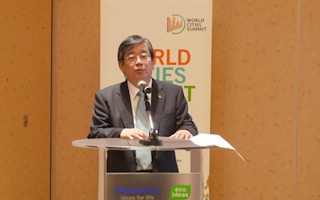Japanese electronics firm Panasonic announced on Tuesday the opening of a new research and development centre for green energy solutions in Singapore.
Panasonic Asia Pacific will invest S$10.2 million over the next two years in the R&D centre - its first outside Japan – for use as a base to develop and commercialise new technology, and then to export it around the world.
Speaking at a media briefing during this week’s World Cities Summit at Singapore’s Marina Bay Sands conference centre, Panasonic managing director for Asia Pacific Yorihisa Shiokawa said the centre was an important strategic move for the company as it continued to increase its green innovations focus.
“Having an energy solutions development centre in Singapore will enable us to develop smart and sustainable solutions for a wider market beyond Japan,” he said.
The responsibilities of the centre’s 22 engineers will include technical assistance for Panasonic’s test-bed project in Punggol Eco-Town, a public housing development in northern Singapore. Launched in August 2011, the project combines rooftop solar panels, an energy storage system, energy efficient appliances and residential energy management systems to create low-carbon housing.
Currently, the solar panel and lithium battery system is undergoing laboratory testing at Singapore’s Nanyang Technological University. Once fully installed later this year, the renewable energy system will power lifts, common area lighting and water pumps with the aim of making the high-rise building energy neutral.
To address household electricity use, Panasonic will provide an initial 10 households with its energy management system, which enables residents to monitor their electricity use. The company will also replace existing air-conditioning units – responsible for 30 per cent of the average tropical household’s electricity use - with new energy efficient units.
Scheduled for installation by the end of this year, the systems will be tested in tandem with smart metres from the Intelligent Energy System (IES) trials. IES is a smart grid pilot programme of Singapore’s Energy Market Authority (EMA). It will provide on-going feedback to customers on their electricity, water and gas use, which will enable them manage consumption more efficiently.
Panasonic and its project partners from the Singapore government - EMA, the Economic Development Board (EDB) and Singapore’s Housing Development Board (HDB) - will use the results from the trial to decide on possible expansion within Singapore after it ends in December of 2013.
EDB assistant managing director Julian Ho, who was also at the briefing, said, “Government agencies such as HDB and EMA are keen to partner with companies like Panasonic to develop system-level solutions to address Singapore’s long-term national needs.”
He added that through the test-bedding of their projects companies could lay a successful track-record for the commercialisation of their technology and its expansion into new markets.
The concept of using a feedback system, known as demand-response, to promote energy efficiency has existed for decades, but widespread implementation has been slow. Industry analysts attribute this to lack of successful large-scale case studies, insufficient government mandates and resistance from consumers, who sometimes view the systems as intrusive.
Yet, evidence exists that the industry is picking up speed. A recent report from cleantech research firm Pike Research predicted that global revenues for demand response services will grow from less than US$1.3 billion in 2011 to more than US$6.1 billion by 2016.
Panasonic’s Yasuyuki Shintani, who is general manager of the new R&D centre, said that growing populations and rapid urbanisation within Asia Pacific had led to a market potential increase of over 200 per cent from 2011 to 2012.
In addition to the existing test-bed programme in Punggol, the R&D team will develop new projects to take advantage of the growing market demand for energy efficiency.
“The centre will make Singapore the launchpad of Panasonic’s sustainable development solutions,” said Mr Shintani.








